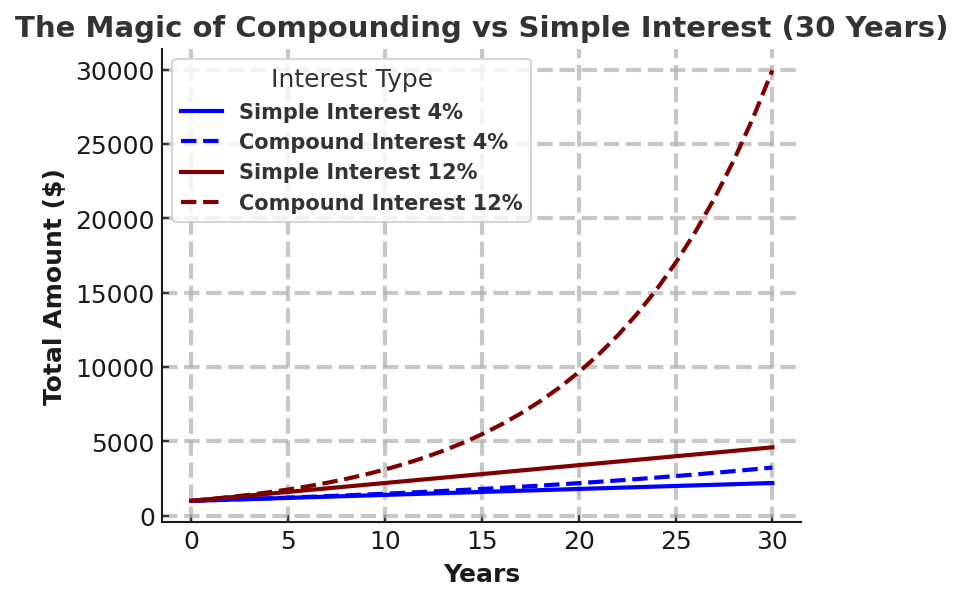Introduction: The Power of Compounding
Einstein famously called compounding the ‘8th wonder of the world,’ highlighting its immense power for growth through the years. Just like planting a seed that lies dormant for years before blossoming into a fruitful tree, compounding works by generating returns on both your original investment and the earnings it accumulates over time. I experienced this firsthand when I planted a persimmon seed as a child. For years, it remained unnoticeable, but after a decade, it grew into a fruitful tree—a perfect metaphor for the quiet, yet transformative, power of compounding.
Compounding Beyond Finances
In this article, we’ll dive into how the principle of compounding extends beyond financial growth to enhance every aspect of our lives. Compounding isn’t just about building wealth—it’s also about cultivating habits, improving skills, and strengthening relationships. Each minor action compounds with time, creating a ripple effect that exceeds the initial effort. Meaningful success stems from the compounded effect of daily, steady progress. By striving to grow just a little every day, we set the stage for extraordinary achievements eventually. Compounding is a marathon, not a sprint, where consistent actions create ripple effects leading to lasting success.
Real-World Examples of Compounding
China’s Economic Rise:
China’s economic rise is a prime example of compounding at work. From 1970 to 2024, the country’s GDP expanded at an average annual rate of ~10%. While that seems modest—it becomes transformative with time. Starting with an economy valued at just $92.6 billion in 1970, China’s GDP has skyrocketed to an astonishing $17.9 trillion today. This extraordinary advancement demonstrates how consistent, compounded progress can lead to monumental change. It’s a powerful reminder that sustained, incremental development is essential for achieving long-term economic success. The same principle applies to your personal growth—whether financial or otherwise. Gradual improvements can lead to exponential results as time passes.
Lessons From Settlers of Catan:
To illustrate this concept on a more relatable level, imagine playing Settlers of Catan with limited initial resources like wood, brick, and sheep. You start by building a simple road and settlement. As the game progresses, each turn brings more resources if the dice favor you. These resources allow you to build more roads, settlements, and eventually cities. The more you build, the more resources you accumulate each turn, enabling faster and more impactful expansion. By continually reinvesting resources into expanding and upgrading, your capacity to generate resources snowballs, and before long, you’re racing ahead of others in the game.
In Settlers of Catan, this compounding effect can take you from a modest setup to dominating the board. Similarly, in real life, investing early and reinvesting gains can accelerate your financial growth over time. The key is consistency and reinvestment, letting each stage of growth fuel the next, just like in the game. This principle of compounding, whether in a board game or in real-world economics, underscores the importance of sustained, incremental progress for achieving significant long-term success.
Understanding the Basic Mathematics of Compounding
At its heart, compounding is the process of multiplying an investment or quantity repeatedly with time, resulting in exponential growth. Rather than just adding to an initial amount, compounding allows it to multiply, dramatically increasing its value as time progresses. Mathematically, this is represented by the formula:
P(t) = Principal x (1+r)^t
Where:
P(t) is the value at a given time.
r is the growth rate.
t is the time elapsed.
Simply put, this formula shows how even a modest, consistent return can grow exponentially with time. Imagine it like a “box of mangoes”—your goal is to fill it to its maximum capacity. To do this, you can apply several strategies, such as starting with a larger initial investment, increasing your growth rate, or allowing your investment more time to compound.
Visualizing the Power of Compounding

The image compares simple and compound interest growth in simulation. The simple interest line grows steadily, adding a consistent amount yearly. The compound interest curve starts similarly but eventually accelerates, as it builds on both the principal and accumulated interest, creating exponential growth. This illustrates that, in finance and personal growth, small, consistent efforts over time lead to significant results.
Strategies to Maximize Compounding Returns
- Start with a Larger Initial Investment: Beginning your compounding journey with a larger principal amount provides a higher base for growth. The earlier and more substantial your initial investment, the more significant your returns will be as compounding takes effect with time.
- Boost the Rate of Return: A higher rate of return accelerates the compounding process. For instance, a 10% annual return will grow your investment far faster than an 8% return over the same period. Even modest increases in the rate of return can have a profound impact on long-term wealth creation.
- Leverage Time (t): Time is one of the most critical factors in compounding. The longer your money stays invested, the more pronounced the compounding effect. What starts as a modest investment can grow exponentially with enough time, making patience a powerful ally in building wealth.
Advanced Compounding Strategies for Wealth Creation
In addition to starting early, increasing your initial investment, and seeking higher returns, there are several key strategies that can significantly boost your ability to compound wealth with time:
- Reinvest Your Returns: Rather than withdrawing dividends or interest, reinvest them into your portfolio. This reinvestment creates a “snowball effect” where your earnings generate further returns, amplifying your wealth gradually. In the stock market, this is known as “dividend reinvestment,” a powerful tool to accelerate long-term growth.
- Minimize Investment Fees: High fees such as annual maintenance fees, can erode the power of compounding by reducing your overall returns. Keeping fees as low as possible ensures more of your investment is left to grow. For example, a 1% fee on a $1,000 investment compounding at 7% over 50 years reduces the total value from $29,457 to $18,420. Lowering fees is essential for maximizing the benefits of compounding.
- Use Dollar-Cost Averaging: This strategy involves consistently investing a set amount at regular intervals, regardless of market fluctuations. By doing so, you acquire more shares when prices are lower and fewer shares when prices are higher, ultimately reducing your average cost per share. This method helps to mitigate the effects of market volatility while maximizing the benefits of the compounding process.
- Focus on Long-Term Growth: Patience is critical when it comes to compounding. The longer your investments have to grow, the greater the potential for exponential returns. As investor Monish Pabrai famously said, “If you can stare at a wall for 30 minutes straight, you can be a great investor.” Long-term focus and discipline are essential to reap the rewards of compounding.
- Start Early: Starting early gives compounding more time to work its magic. Even modest contributions made at the beginning can grow into significant wealth over time. For example, investing $100 a month starting at age 25 with an average annual yield of 7% would grow to over $200,000 by age 65. If you start at age 35, the total would be just over $100,000—even with the same monthly contribution. Starting early is one of the most effective ways to build wealth through compounding.
The Rule of 72: A Quick Way to Estimate Investment Growth
To maximize the benefits of compounding, start early, invest consistently, and aim for higher returns. The more you invest and the sooner you begin, the greater the growth. The Rule of 72 is a quick way to estimate how long it will take to double your investment. Simply divide 72 by your annual return rate. For instance, a 6% return means it will take about 12 years to double your money (72 ÷ 6). This easy formula lets you gauge compounding’s impact without complex math.
So, the next time you’re wondering how long it will take for your investment to grow, you won’t need a calculator or to browse online—just apply the Rule of 72 and get an instant estimate!
Compounding Wealth: Building Financial Freedom
As angel investor Naval Ravikant famously advises, building wealth isn’t about trading time for money—it’s about making your money work for you. Think of each dollar as a hard-working employee generating returns on your behalf. For example, at a 10% annual interest rate, one dollar becomes $1.10 after a year. But the magic lies in letting those returns compound. After 10 years, that same dollar grows to ~$2.6, and after 50 years, it could balloon to an impressive ~$117—all without additional contributions.
This illustrates the extraordinary power of compounding—your wealth grows exponentially with time and consistent returns. The earlier you begin, the longer your money has to work for you, leading to significant financial outcomes. Starting young gives your investments decades to compound, turning even small contributions into life-changing sums.
Compounding Beyond Money: Building Strong Relationships
In cultivating meaningful relationships, the key lies in the small, thoughtful actions that gradually build lasting bonds. Simple gestures—a hug, a smile, sharing a warm drink, or taking a leisurely walk together—can significantly enhance our emotional connections. For instance, my evening walks with my husband have deepened our relationship more than I could have imagined. These regular, intentional acts of kindness, though seemingly simple, lay the foundation for strong, fulfilling connections built on love and mutual respect. By prioritizing these moments, we create a resilient relationship that stands the test of time.
Relationship research consistently supports the power of small, daily gestures in fostering emotional connection and long-term partnership satisfaction. Experts emphasize the importance of nurturing bonds through consistent care and presence, highlighting the role of intentionality in strengthening relationships with time.
Next time you have the chance, invest in small, meaningful gestures with those you care about. Your effort today will compound into a stronger, more resilient relationship tomorrow.

Learning and Compounding Knowledge Over Time
Just as we see compounding in our finances, the same principle applies to how we accumulate knowledge and skills with time. Learning extends far beyond formal education—often, the most valuable lessons emerge from unexpected sources. For instance, I had little understanding of personal finance until I overheard a conversation between my husband and a friend discussing investment strategies. That moment sparked my curiosity, prompting me to explore financial management on my own. My journey began with The Little Book of Common Sense Investing by John Bogle, and over the next six years of consistent learning, I developed the confidence to make informed financial decisions.
This experience highlights the power of self-directed learning and illustrates how a single spark of curiosity can evolve into a lifelong pursuit of knowledge. As Warren Buffett wisely put it,
“Read 500 pages every day. Knowledge builds up like compound interest.”
Personal growth is often driven by the desire to learn beyond traditional classrooms, and the habit of continuous self-improvement can lead to transformative changes in our lives.
Compounding Habits for Personal Growth and Success
Compounding plays a crucial role in shaping our habits. At first, actions require conscious effort, but with consistent practice, they gradually become automatic. Over time, these actions move from demanding focused attention to becoming ingrained in our subconscious. As James Clear highlights in Atomic Habits,
“Habits are the compound interest of self-improvement. Getting 1 percent better every day is a powerful way to build habits that compound with time. Small improvements can lead to massive results, but only if they are consistent.”
Eventually, the brain no longer needs to actively engage in decision-making for these tasks, allowing them to become second nature. This effortless execution indicates that the behavior has been solidified in our neural pathways, demonstrating the transformative power of habit formation through consistent, intentional practice.
Imagine someone who has been smoking for years and decides to quit. In the beginning, each day without a cigarette takes a lot of conscious effort. However, by making small, consistent choices, like opting for a walk instead of smoking, the cravings slowly lessen. With time, these healthier alternatives become automatic, and quitting smoking becomes a habit. This process mirrors the compounding effect of habits, where consistent actions eventually lead to significant, lasting change. What once seemed like a daunting goal becomes an effortless part of their daily routine.
Like a seed planted in soil, small actions in relationships and habits may not show immediate results, but with time and attention, they can grow into something far more significant. Just as financial compounding turns modest investments into large returns, daily efforts in our personal lives compound into stronger, more meaningful connections and lasting success.
Compounding in Everyday Life: The Power and Pitfalls
Compounding isn’t just a theoretical concept confined to financial markets. We witness its effects in our daily lives. For instance, the rising cost of groceries is a prime example of compounding inflation. With time, even small annual price increases accumulate, leading to significantly higher costs. This gradual erosion of purchasing power highlights how compounding can work against us as well as for us. Just as minor, consistent gains can build wealth, minor, consistent losses can diminish our financial power. Understanding this principle empowers us to make informed decisions and take proactive steps to mitigate its negative impacts, such as investing in inflation-protected assets or adjusting our spending habits.
Conclusion: Embrace the Power of Compounding in Every Aspect of Life
In conclusion, the power of compounding goes far beyond financial growth—it’s a transformative principle that shapes all areas of life, including relationships, learning, and personal habits. By making gradual investments over time, we lay the groundwork for meaningful, lasting change and remarkable success. Just as a tiny seed blossoms into a thriving tree with patience and nurturing, our investments—whether in wealth, knowledge, or connections—compound exponentially with time. As you embark on your journey, keep in mind that compounding is not just about growing money—it’s about embracing the quiet, yet powerful impact of consistent progress. So, what’s one small action you can take today to start your compounding journey?
For your reading:
- The Power of Compound Interest: Calculations and Examples
- Compound interest: The 8th wonder of the world
- How Warren Buffett’s Reading Habits Contribute to His Success
- The Mighty Impact of Small Gestures in Everyday Life
- Atomic Habits: An Easy & Proven Way to Build Good Habits & Break Bad Ones
Writer: Ankita Pujar
Editor: Dr. Robin Garg



Pingback: Money 101: Best Budgeting Strategies for Financial Freedom -
Pingback: A Year of Insights: Canvas to Cosmos’ 2024 Review -